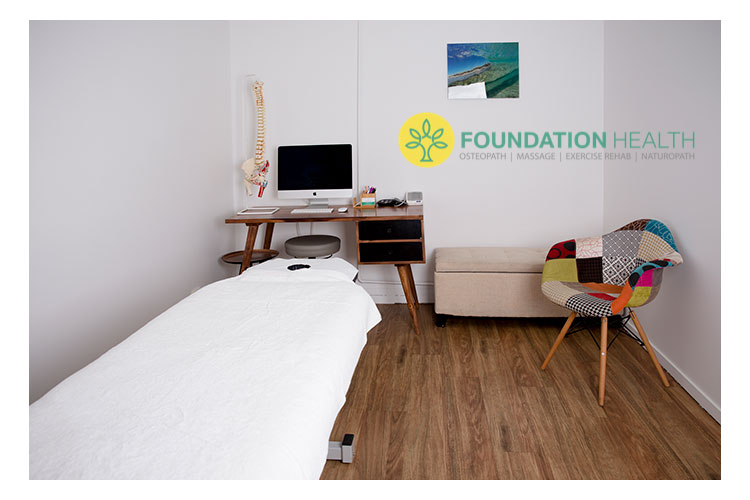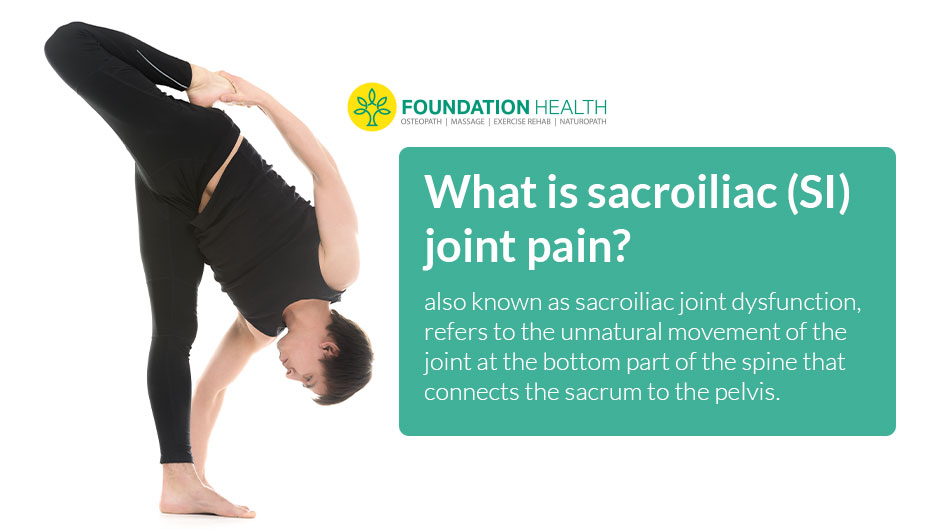The sacroiliac (SI) joint is located between the base of your spine and pelvis. It can become inflamed or irritated for a number of reasons, causing significant pain in the lower back and glutes.
Sacroiliac (SI) joint pain affects between 15 and 30% of individuals with chronic, lower back pain.
This type of pain can be difficult to diagnose because it often mimics other conditions such as disc herniation, Joint facet syndrome, and even sciatica.
In order to determine the cause of pain, a thorough physical osteopathic examination is necessary.
What is sacroiliac (SI) joint pain
SI joint pain (also known as sacroiliac joint dysfunction) refers to the unnatural movement of the joint at the bottom part of the spine that connects the sacrum to the pelvis.
Unnatural movement refers to hypermobility (too much movement in the sacroiliac joint) or hypomobility (too little movement in the sacroiliac joint).
As a result, you may experience pain in your lower back, legs, glutes or sacroiliitis, inflammation of the joints.
The pain from a sacroiliac joint dysfunction may spread to surrounding muscles, resulting in muscle spasms.

Common causes of sacroiliac joint pain
1. Trauma
Anything that causes a sudden force to be transmitted down through the pelvis can put a great deal of strain and injury to the SI joint.
Motor vehicle accidents, falls and even childbirth can cause injury to the SI joint.
2. Poor biomechanics
A biomechanical injury can occur over time, when a person starts a new sport, or when they rapidly increase their level of activity. A twisted pelvis, unequal leg lengths, and muscle imbalances are common biomechanical SI joint injuries.
3. Hormonal causes
During pregnancy, hormonal causes of SI joint pain occur when the ligaments of the pelvis become softer and wider in preparation for birth. In addition to causing ligaments to stretch, adding more weight and pressure can lead to injury and pain.
4. Degeneration
The good news is that with modern medicine, we’re living longer. The bad news is that our joints are wearing out and breaking down as we age.
Degeneration is a normal age-related condition that occurs in most of our joints. It is very well known that we develop arthritis in our hips, knees, and other joints as we age.The role of the Osteopath is to maintain the mobility of the joints as we age.
A subcategory of degeneration is lumbar fusions.
A lumbar fusion is a surgical procedure in which the vertebrae in the lumbar spine (lower back) are joined together, minimising vertebral movement.
When you fuse a joint, you transmit more force to the adjacent joints.
Since the SI joint is considered an adjacent segment (joint) it can therefore degenerate after a prior lumbar or lumbar sacral fusion.
Can osteopathy help with SI joint pain?
Osteopathic treatment for sacroiliac (SI) joint dysfunction has been shown to provide effective relief for many individuals suffering from this condition. The goal of osteopathic treatment is not only to relieve current symptoms but also to prevent future recurrence of the problem by restoring normal function (where possible) in the affected area.
Osteopathic treatment for sacroiliac joint dysfunction
In order to determine the cause of your sacroiliac joint dysfunction, one of our experienced osteopaths will take a thorough case history, examine you thoroughly, and conduct diagnostic tests to determine the underlying cause.
When treating any aspect of the pelvis, all the structures that make up the pelvis must be aligned and released to create balance and stability between the pelvis and the spine.
To achieve this, our osteopaths use a variety of techniques which may include joint manipulation, joint mobilisation and sports massage depending on the age and severity of the injury or condition.
We may also give you exercises to perform at home and postural advice based on the results of your assessment.
What aggravates sacroiliac joint pain?
Performing high impact activities such as running, jumping, contact sports, labour intensive jobs, or standing for long periods can aggravate SI joint pain.
Pain can also be aggravated due to weak and deconditioned abdominal, gluteal, and spinal muscles.
What is the best sleeping position for sacroiliac joint pain?
When lying down, use pillows to support your hips and pelvis for better alignment to alleviate SI joint pain.
Place a pillow beneath the lower abdomen if you are a stomach sleeper.
If you are a side sleeper, place a pillow between your knees and ankles.

Final thoughts
We understand that living in constant pain isn’t easy, which is why we offer osteopathic treatments that are personalised for each patient.
Our goal is to provide relief from pain, increase your mobility, whilst also educating patients about their condition so they can make informed decisions about their care options going forward.


